The mad, mad, mad, mad world: The future of global energy
The humanity witnesses an unprecedented dramatic leap of energy consumption, defying the future of the main energy sources, which are unfortunately nonrenewable: oil, gas, and coal. This leap reminds of the marvelous ironic film by Stanley Earl Kramer “It’s a Mad, Mad, Mad, Mad World,” which came out half a century ago, in 1964. Certainly, people of older generations remember it. The plot, which seemed mad to Kramer, looks like tricks played by adults as compared with the realia of the present. Indeed, the world we live in is going mad: collapses of the Soviet Union and Yugoslavia, Afghanistan, Iraq, Libya, Syria, Ukraine (where I was born 80 years ago), and the folly of global energy consumption. It is for this reason that I borrowed the title of Kramer’s movie for this article
We must leave our descendants a global energy system that will spare them
from the conflicts and nonconstructive ways of struggling for energy supplies.
V.V. Putin
This article was written in the autumn of 2013 as an invited lecture I delivered to the meeting of the winners of the International Global Energy Prize in the European Parliament in Brussels on November 24, 2013, where European parliamentarians were present. Although the relationships between the European Union and Russia have cooled down despite the climate warming, I leave the text as it was. I think that this cooling only emphasizes the madness of the world we live in.
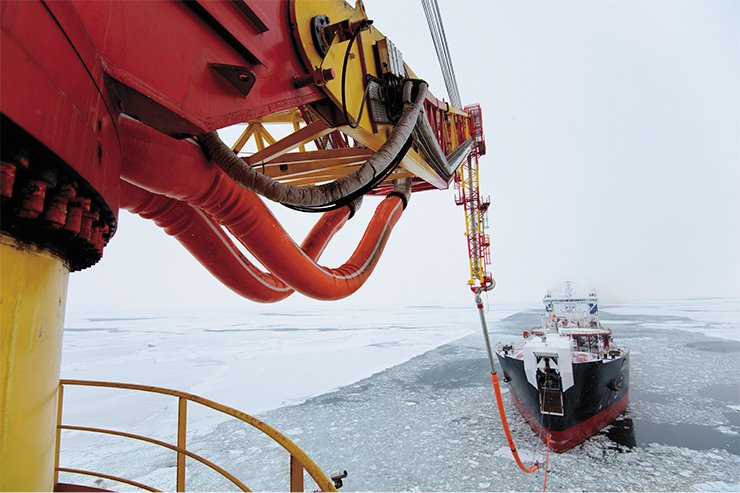
The position of Russia on global energy security
It is known that energy security is an integrated concept, which implies energy supply to a state and all its citizens at prices affordable to consumers and economically sound for manufacturers. This multifaceted problem is in the focus of careful attention of the governments of the leading countries in the modern world, including the European Union and Russia, which have been conducting an ongoing dialogue in this regard. Therefore, I consider it necessary to start the discussion with outlining the position of Russia. It was exhaustively set out by the Russian President V.V. Putin. He said, “The new policy of the leading countries should be based on the understanding that the globalization of the energy sector is inseparable from energy security. Our common future in the area of energy means common responsibilities, common risks and benefits.”
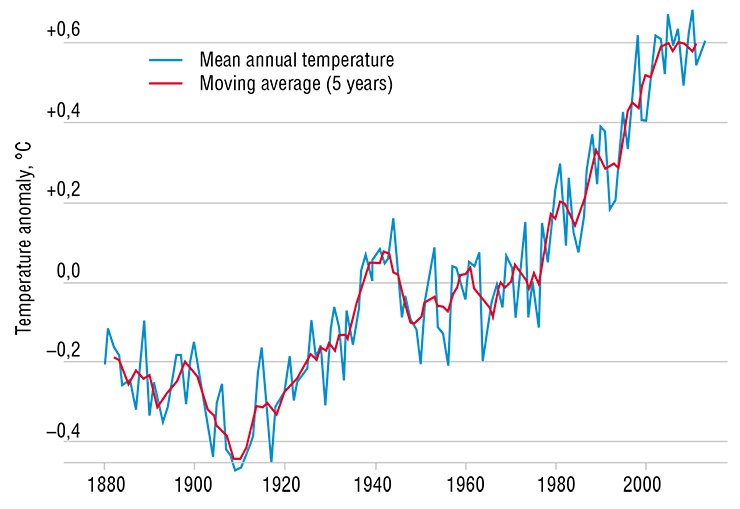
Putin indicated that the strategy for achieving the global energy security “should be based on a long-term, reliable, and environmentally sustainable energy supply at prices affordable to both the exporting countries and the consumers.”
This is the position of Russia on global energy security in the broadest strokes. It is steadfast and clear-cut. It is known that the G8 and EU countries constantly focus their attention on the problems of global energy and global energy security. It appears to me that the decisions of G8 made in Gleneagles (United Kingdom) and in St. Petersburg (Russia) are fairly close to the viewpoint outlined by the Russian President.
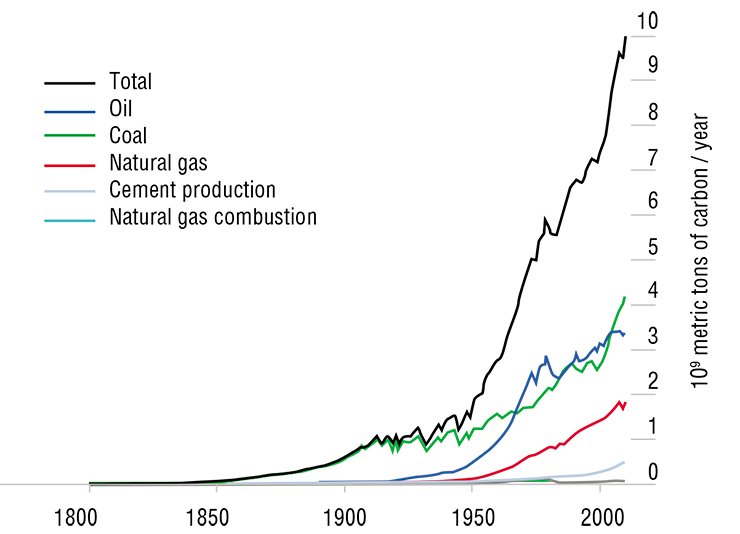
A brief article cannot elucidate all the title items in sufficient detail. Therefore, we will consider only some of them, presented as highlights:
- Climate warming on the Earth during the 20th century is a conclusively established fact.
- Role of the greenhouse effect in climate warming: Chills or reality?
- The mad world. Which is the greater hazard: climate warming or fossil energy depletion? Energy resources will not be cheaper.
- The woeful heritage of the 20th century. Economic and political consequences of natural resource depletion. UN objectives.
- Gas is more abundant on the Earth than scientists used to believe quite recently. A gas relax is in store for the humankind. It will be the time for development and introduction of “pure” energy technologies.
- Russia is willing to remain a reliable partner of the EU in the delivery of energy sources in the 21st century.
Climate warming on the Earth in the 20th century is a conclusively established fact
Ample data processed in many research centers convincingly prove that the Earth’s surface temperature rose constantly if averaged over sufficiently long periods, covering year-to-year fluctuations. It increased by 0.8°C within 100 years, from 1910 to 2010. In addition to temperature records, there are other parameters proving climate warming. They include changes in the Arctic Ocean water area covered by ice. It decreased notably over 25 years. With regard to these observations, the UN Intergovernmental Panel on Climate Change (IPCC), upon consultation with the national academies of G8 countries admitted that the mean temperature of the Earth’s surface had increased since the beginning of the industrial revolution (second half of the 18th century). As mentioned above, judging from published data, the temperature rise began about 1910.
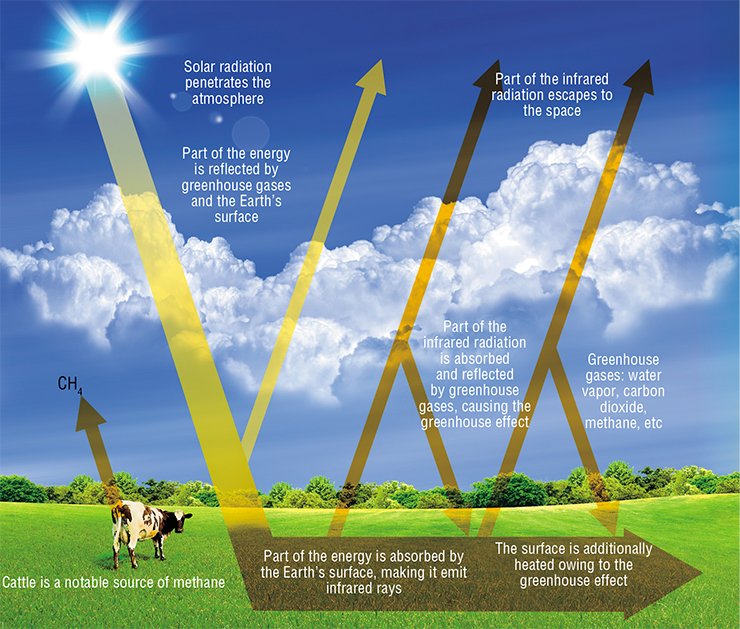
The question arises: What brought about this warming?
Chills or reality?
There are two viewpoints as to the causes of the observed climate change. Some scientists associate it with cosmic events, taking into account the fact that climate changes repeatedly occurred in the Earth’s history, as shown by paleoclimatic reconstructions based on geologic data.

The other major group of scientists attribute the warming to human activity. Huge amounts of methane and carbon dioxide enter the atmosphere because of the development of oil, gas, and coal deposits and energy production resulting from the combustion of fossil fuels. Forests scavenge some of the carbon dioxide. However, this beneficial effect is diminished by the intense forest devastation. Methane and carbon dioxide come to the top of the atmosphere and form a trap for infrared rays reflected from the Earth’s surface. This absorption hampers the Earth’s cooling and results in climate warming. It is termed the greenhouse effect.
The carbon emitted in the form of dioxide resulting from the combustion of coal, oil, gas, and other sources comes into the atmosphere. Coal ranks first among the sources of СО2 emission, followed by oil. Gas ranks third, falling far behind the first two.
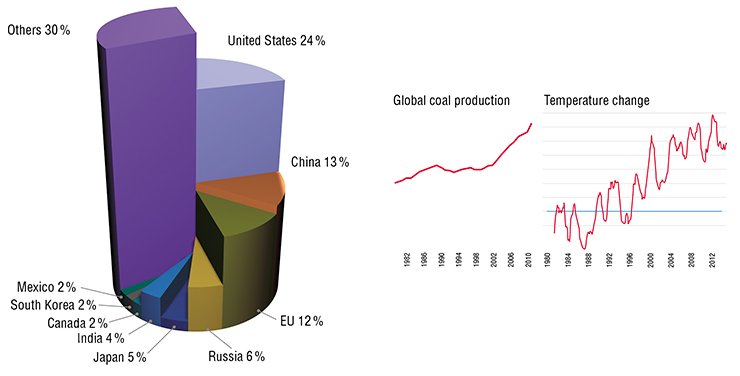
Taken the continuous growth of the consumption of fossil fuels, it is natural to expect a further acceleration. Estimations obtained by the computational simulations of the Earth’s climate suggest that the mean surface temperature will increase by 1.8 to 3.4°C by the beginning of the 22nd century.
“RELATIVE AMBIGUITY” The problem of the anthropogenic influence on global warming was discussed at the United Nations Conference on Environment and Development, Rio de Janeiro, 1992; at the international meeting in Kyoto, 1997; and at many other conferences. In 2005, the G8 summit at Gleneagles, United Kingdom, declared, “…we know enough to act now to put ourselves on a path to slow and, as the science justifies, stop and then reverse the growth of greenhouse gases.” However, it is not definitely known whether the climate warming is associated with human activity. The same G8 summit (Gleneagles, 2005) cautiously mentioned, “Uncertainties remain in our understanding of climate science.”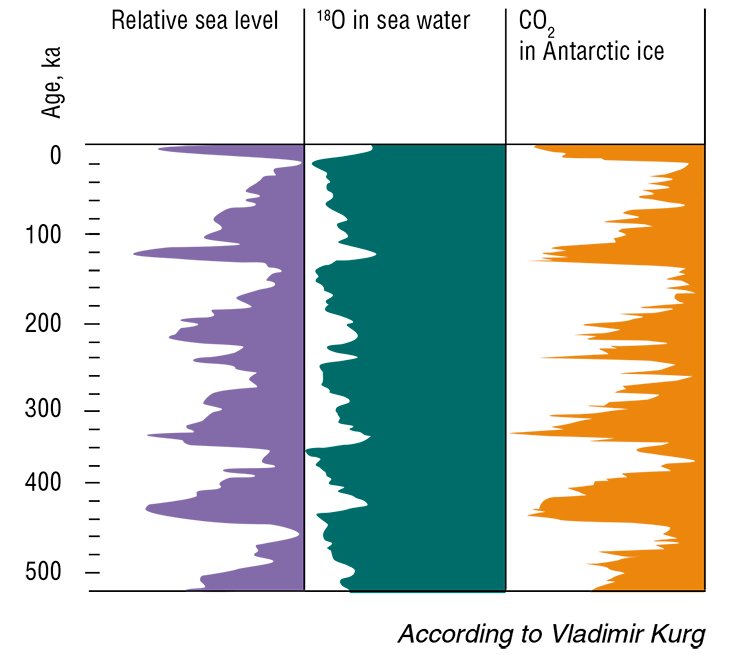
Here are some examples supporting this statement.
Example 1. Variation in the mean annual temperature on the Earth’s surface shows clear growth starting from 1980. The temperature growth slows down after 2000. Comparing this course with the history of coal production and consumption, we see that the production and consumption increased dramatically just in 2000; consequently, so did the emission of carbon dioxide and coal methane. Within the last 10–12 years, coal production and consumption have increased more than in the entire 20th century! The greenhouse effect theory predicted that the growth of the Earth’s surface temperature would accelerate in these years. But it did not. The discrepancy requires explanation.
Example 2. Drilling in the ice sheets of Antarctica and Greenland allowed reconstruction of the contents of the 18O isotope in seawater and CO2 in the atmosphere over the last 500,000 years. Simultaneously, the variation of the sea level in the same years was reconstructed. Six episodes were detected in which atmospheric CO2 contents reached the present value and the climate grew warmer. At least, five of them were not associated with industrial activity. It is the second discrepancy that demands explanation.
Example 3. The reconstruction of the Earth’s temperature over the last 500,000,000 years made on the base of the geologic record is greatly illustrative. It shows that during most of the Earth’s history its temperature was notably higher than now.
Thus, the Earth has experienced repeated temperature rises.

These examples are not aimed at the substantiation of the impracticability of combatting enormous anthropogenic emission of gases and liquids into the atmosphere. They merely show that the excessive focus of governments and the business community on this problem may draw investments from other environmental problems, studies of “pure” energy, control of diseases, poverty, and many other global and regional challenges.
Developing the theme of G8 leaders, we note that there are still controversies not only about the scientific substantiation of climatic changes on the globe but also about the choice of priorities in the policies of developed countries for the benefit of all nations of the Earth.
United States rank first in the weight of emitted greenhouse gases; China, second; EU countries, third; Russia, fourth; Japan, fifth; and India, sixth.
The graph illustrates the emission of greenhouse gases by countries burning most of fossil fuels in 2000.
Observations indicate that even now the temperature growth on the Earth’s surface, whatever its nature, causes glacier thawing, permafrost degradation, eustatic sea level rise and desertification of vast areas, etc. In other words, these changes alter dramatically the human environment.
The mad world. What is the greater threat: climate warming or fossil energy depletion?
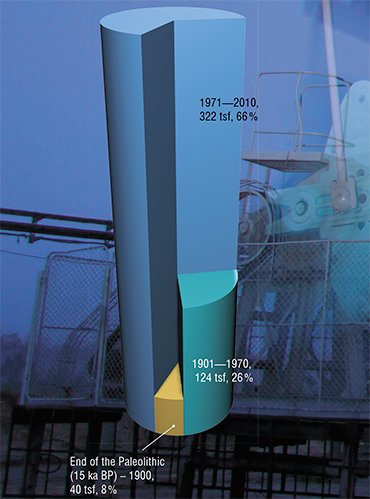 Energy resources will not be cheaper.
Energy resources will not be cheaper.
Relying on the world statistics, my disciples and I estimated the energy resources consumed by humankind since the end of the Paleolithic till now, i.e., for approximately 17,000 years. We have seen that people had utilized about 40 billion tons of standard fuel (tsf) before the beginning of the 20th century, that is, until 1900. The fuel included straw, wood, coal, and minor amounts of oil. Over the first 70 years of the 20th century, until 1971, people consumed three times as much energy resources, slightly more than 120 billion tsf. Over the next 40 years, from 1970 to 2011, 322 billion tsf. To put it another way, only 8.2% of the energy resources consumed by humankind over the whole time of its existence accrue to the first 17,000 years; 25.7%, to the first 70 years of the 20th century; and 66.1%, to the last 40 years. An enormous acceleration in energy resource consumption is apparent.
As noted at the beginning of the article, this energy consumption growth is nothing but the madness of the modern world. In this regard, one cannot help but wonder whether the global market can cope with this madness without the help of the governments. Theoretically “Yes” but actually, the answer cannot be anything but “No.” In this point, I agree with E.M. Primakov. It is for this reason that I quoted the name of Kramer’s film in the title of this section.
In the 20th century, the global power industry shifted from coal-based (unisource) to diversified. There is every reason to regard the second half of the 21st century as an energy revolution in the human history.
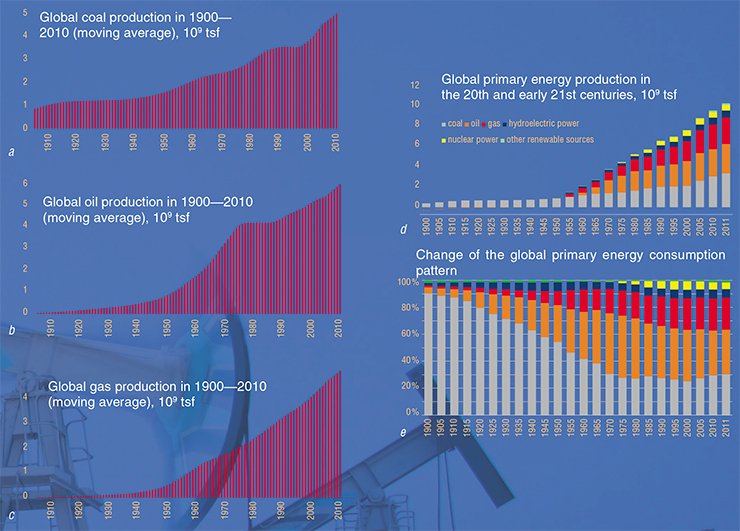
It is natural to ask whether the unrestricted growth of production and consumption of energy sources can last forever. Certainly not. The resources of all fossil fuels are limited. Although they are renewed in the present geologic epoch, the rates of the industrial recovery of coal, oil, and gas many times exceed the rates of their formation. Consider the prospects of increasing the recovery of major energy commodities.
Oil. Forecasts obtained by the experts of the Trofimuk Institute of Petroleum Geology and Geophysics, Novosibirsk (IPGG), show that the initial global recoverable resources of conventional oil exceed 380 billion tons with a probability of 0.95. The mean predictive estimate of global recoverable resources of conventional oil is 510 billion tons. The cumulative oil recovery is 165 billion tons; explored reserves are 162 billion tons; and inferred resources, 183 billion tons.
With regard to the structure of the initial global conventional oil resources and trends in the development of extractive industries, it is most probable that the production of conventional oil in the world will reach its maximum in 2020–2030, and the maximum annual production will be 4.2–4.8 billion tons. The main regions of conventional oil recovery will be the catchment area of the Persian Gulf, West and East Siberias, Caspian Sea region, and petroliferous basins on the Atlantic shelves of Africa and South America, including the Mexican Gulf region. The recovery of conventional oil will decrease after 2025–2035.
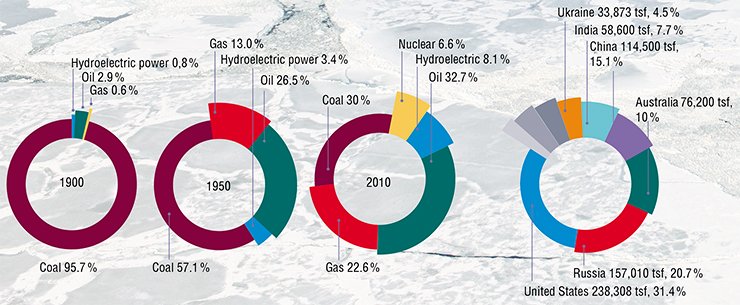
Coal. Coal resources and reserves, as well as other mineral resources, are irregularly distributed over geologic regions and countries. The United States and Russia possess over 50% of the global coal reserves, or 395 billion tons.
It is predicted by the IPGG that there will be a slowdown in the growth of coal recovery as compared with the last 15 years because of environmental and resource restrictions. The maximum production of coal, about 10–12 billion tons per year, is expected in 2030–2040. After that, the production will remain constant for some time (a “shelf”) and then it will gradually decrease. Further growth of coal recovery will be impossible not only for environmental reasons but also because of the limited resource base. The opinion that coal reserves will suffice for centuries is a myth. As noted above, most of the prospected coal reserves belong to the United States and Russia. These countries also possess enormous petroleum resources; therefore, they will have no zest for the intense development of coal industry. Their maximum annual coal production in the future is unlikely to exceed 1,400 million tons. The portion of coal reserves (431 billion tons) outside the United States and Russia, with the peak production of 10–11 billion tons in the world, will be nearly exhausted in the 2060s!

Gas. The situation in the gas market is expected to be more encouraging. The weight of evidence suggests that the global resources of both conventional and nonconventional gas have long been underestimated. In the recent decades, impressive discoveries were made in many regions of the globe. The gas fields North–South Pars (Qatar, Iran) and South Yolotan (Central Asia, Turkmenistan) appear to be the greatest in the world. Their gas reserves overpower even the Urengoi deposit in northern West Siberia. The latter statement, however, lacks proof. Prominent discoveries were made in Australia, where the Greater Gorgon gas fields were discovered and are now prepared for exploitation. A new sea gas giant was found north of Australia, in Papua New Guinea. Gigantic discoveries were made in Russia. In East Siberia and Sakha Republic (Yakutia), giant fields — Kovykta, Chayanda, and others — have been discovered and prepared for exploitation in New gas giants were found in the continental shelves of Sakhalin and of the Arctic Ocean seas (Shtokmanovskoye, Leningradskoye, Rusanovskoye). More gas fields were found in West Siberia, the Kara Sea, the Gulf of Ob, and the Taz Estuary. Innovative solutions concerning the development of shale gas and coal methane attract much attention. All these findings will cause dramatic changes in the global gas market: appearance and rapid development of new complexes producing both conventional and nonconventional gas. Of all fossil energy commodities, the production and consumption of natural gas will increase most rapidly. According to our forecast, the global gas consumption will increase from 3.4 to 5.7 trillion cubic meters by 2040.
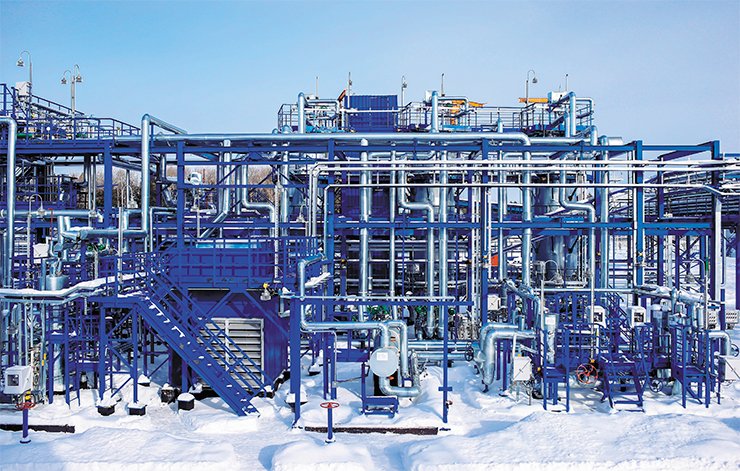
A slower growth, stabilization, and then a decline in the production of oil and gas against the continuous growth of the economies and demand for energy supplies in the Pacific Rim and Russia as well as the slowly but steadily growing demand for energy supplies in the the European Union and North America and a growing population of the Earth will result in a sharp demand growth for energy supplies and exacerbation of the struggle for dominating the energy markets.
Given this situation, it is hardly probable that the prices of energy supplies will decrease. The opposite is much more likely.
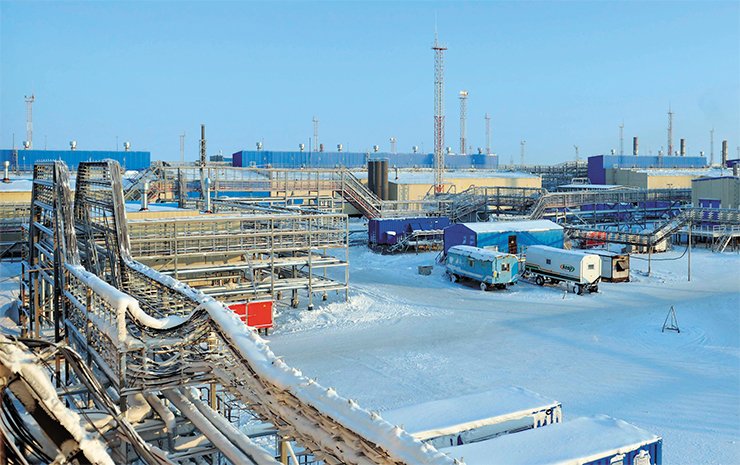
The forthcoming shortage of conventional energy commodities is no lesser threat for the stable development of humankind than climate warming. In my opinion, it is greater. Anyway, in long-term forecasts both these threats should be taken into account .
The woeful heritage of the 20th century: Economic and political consequences of natural resource depletion. UN objectives
We have inherited from the 20th century not only outstanding achievements of human genius in science, culture, and medicine, an advanced energy system, a powerful industry and highest technologies, but also lots of unsolved problems. Here we confine ourselves to three of them.
Problem One is what we discussed in detail above. It is the intense, sometimes destructive exploitation of mineral resources, bringing about the prospect of their exhaustion in the 21st century. In the 20th century, humankind as a whole could afford unlimited production and consumption of mineral resources, in particular, of energy sources. Things are different now. Making projections for the 21st century, people should realize that the conventional resources of oil, gas, and coal will largely have been developed by the end of the century, and the search for alternative or new energy sources and the development of a new energy system will come to the fore. Many countries including the United States, the European Union, Australia, Canada, China, Russia, Japan, and Venezuela have already started searching for solutions. There is a long way to go and an enormous demand for investment. However, this is an R&D problem, and it will certainly be solved.

Problem Two is climatic changes, which may significantly complicate the natural climatic conditions and socioeconomic development of many regions and countries. Although it is a matter of controversy whether these changes are generated by natural cyclic processes or stem, partly or entirely, from human activities, the humanity and scientific community should keep a close eye on these processes and investigate them. If it is confirmed that this is a purely natural phenomenon and industrial activity exerts little effect on it, we should learn to minimize its adverse consequences. If we find that certain human activities induce or aggravate climatic changes, then their adverse effects should be minimized or these adverse activities should be stopped entirely.
Problem Three is the horrific disparity in the distribution and consumption of energy supplies. Advanced countries, which house 10.6% of the global human population, consume 55% of oil (more than two tons per capita) and 40.3% of all energy. Two groups of countries, where oil consumption exceeds one ton per capita, house 21.2 % of the population and consume 69.1% of all oil and 64.1% of energy. In contrast, about 80 % of the global population consume 21.9% of oil and 28.7% of energy. Many of these poorest countries have started intense economic development. The most notable of them are China and India. Their development requires enormous energy resources. Just these two countries, together with Australia and Indonesia, engineered the recent unprecedented growth of global coal production. As noted above, the potential of coal energy is limited. In the 2030s–2040s, when the production of conventional energy commodities will cease to increase and the demand for them in the developing countries will be growing, the issue of the equitable distribution of energy supplies will come up. This time is round the corner. Since its emergence, an unregulated market has never produces fair distribution – and it will do it in the future. The nations and governments of advanced countries, both producing and consuming energy supplies, United Nations, and the entire humanity should be prepared for the formation of this new order of energy supply distribution.
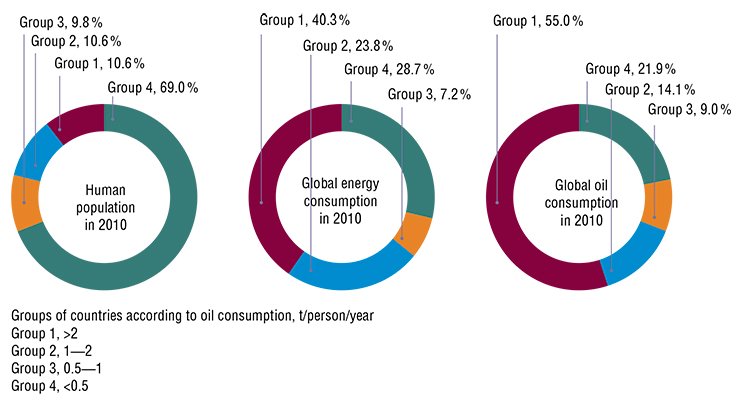
I suppose this is what the Russian President V. V. Putin meant when he said, “In addition to reconciling the interests of stakeholders in global energy interaction, we will have to identify practical measures to ensure a sustainable access of the world economy to traditional sources of energy, as well as to promote energy-saving programs and develop alternative energy sources.
A balanced and fair energy supply is undoubtedly a pillar of global security at present and in the years to come. We ought to pass on to the future generations a world energy architecture that will help avoid conflicts and counterproductive competition for energy security.”
Russia remains a reliable partner of the EU in the delivery of energy sources in the 21st century
In view of all this, it is natural to ask me what prospects I, a nonpolitical scientist, can see in the energy cooperation between the EU and Russia. I am sure that the future of this cooperation in the 21st century is promising.
What can hamper it? The absence or depletion of the material base. Everybody knows that Russia will not have to face this problem for many decades to come, especially as far as gas is concerned.
Russia has huge natural gas reserves and resources. It can readily increase its production. The production is limited by the demand for gas in the European market rather than by the material base. In particular, the development of the giant Shtokman gas field was suspended because of the absence of a reliable long-term market and a high production cost of the gas. Russia’s entry of to the Pacific gas market will not have an adverse effect on its ability to supply gas to Europe.
The commitment and long-term intentions of Russia concerning the European gas market are confirmed by the intensive activity of the President of Russia, Russian Government and Gazprom in the implementation of the Nord Stream and South Stream gas pipeline projects. In the nearest future, Russia will be able to supply gas and LNG to EU countries.
As for oil, it will be difficult for Russia to increase its production after 2020, although it is within the realm of possibility. East Siberia is a region where oil production can grow. Several giant and large fields are to be developed in the Krasnoyarsk Krai, and there are more large fields in the Irkutsk Oblast and the Sakha Republic (Yakutia). In West Siberia, there is a tremendous potential of oil production increase owing to the shale oil of the Bazhenov Formation. This is a unique site for the future oil industry in the Russian Federation. In addition, Russia has huge reserves for saving resources. I mention but two of them. The first is to deepen oil processing to 90–95%, and the second is to convert the Russian petroleum chemistry from oil to ethane and the propane–butane fraction of fat gas from deep-seated Cretaceous horizons in northern West Siberia and in East Siberia.

These prospects provide practically infinite possibilities for mutually profitable partnership. Russia has to create giant-powered capacities for gas processing and petroleum chemistry. Many European companies are already involved in this program, and the cooperation is strengthening. For example, ways of possible cooperation with the European companies have been outlined in the development of the petroleum resources of the Arctic seas.
Finally, coal. Being second in coal reserves, Russia has a history of coal supply to the European market. The prospects of Russian coal export, primarily from the Kuznetsk Basin, are practically unlimited.
Our cooperation can be hampered by a failure or reluctance to negotiate. In my opinion, the history of the last five or six decades shows that this problem is also inexistent. I suppose that the talks about sanctions caused by the situation in Ukraine are futile. They will be forgotten within the lifetime of their authors.
Obviously, energy-related projects can be implemented only on a mutually profitable basis. What does it mean? I will quote V.V. Putin: They “should be based on a long-term, reliable, and environmentally sustainable energy supply at prices affordable to both the exporting countries and the consumers.”
The cooperation between Russia and the EU should provide grounds for new, innovative decisions. Russia and the EU countries can and should cooperate in the development of innovative technologies in energy conservation; recovery and processing of oil, gas, and coal; petroleum chemistry; coal chemistry; coal and petroleum machine building; basic studies; and the creation of the technological grounds necessary to furnish humankind with energy in the future.
I feel it is my duty to mention another problem, which, as far as I realize, frightens many Europeans. I see that the Chenobyl and Fukushima disasters had great impacts on human psychology, which checks the development of atomic energy industry. However, it is my strong conviction that this industry is mandatory for developing energy systems. Obviously, it is important to take every measure to improve its safety. Certainly, the humanity should continue research in mastering the energy of controlled thermonuclear fusion and hydrogen energetics.












